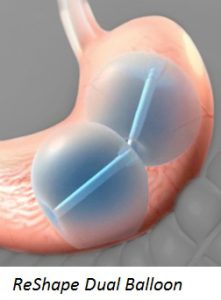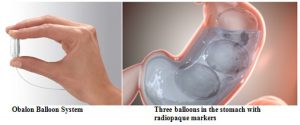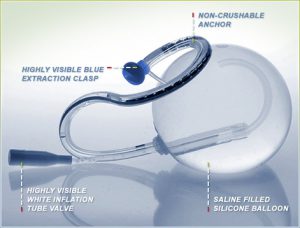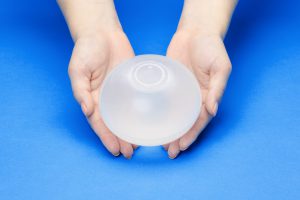The gastric balloon procedure is designed to install an inflated saline-solution filled or gas-filled balloon in your stomach for a period of around six months, which leaves less room in your stomach for food and other stomach contents. Thus, you will feel fuller sooner while you are eating and therefore will eat less, allowing you to lose between 25 and 50 pounds over the period of six months while the balloon is in place, losing approximately 1 to 2 pounds per week. You should also notice an improvement in other areas of your health, such as a reduction in joint and bone issues, diabetic issues and heart-related issues. With behavior modification, you should also be able to keep the weight off for longer, if you can modify your relationship with food during the time where the balloon is present in your stomach.
It is important to make sure that you consider all the facts and information relating to this procedure, including the risks and potential complications, the benefits and the drawbacks when determining whether this is the right procedure to meet your needs. There is no one size fits all solution when it comes to weight loss surgery, and you will want to make sure that you are choosing the procedure that is going to best benefit your unique situation.
Do I Qualify for Gastric Balloon?
In the U.S., you qualify for a gastric balloon procedure if you have a body mass index in the 30 to 40 range. For other countries, the BMI requirement in order to qualify for a gastric balloon procedure is typically less, only requiring that you have a BMI that is over 27. For some types of balloons, such as the ReShape Balloon, you may be required to also have a health risk that is associated with obesity, which is known as a comorbidity. Some examples of comorbidities are sleep apnea, diabetes and high blood pressure. There are other balloon types, such as Orbera, which do not require that you have a comorbidity in addition to the BMI requirement. Make sure that you know what the requirements are when considering whether or not you qualify for the gastric balloon procedure that you are considering, because they can vary from balloon to balloon.
Different Types of Gastric Balloon Surgeries
Each gastric balloon procedure is a little bit different in terms of its basic mechanism and the results it offers, so make sure that you consider each of the options available to you before settling on the right option to meet your needs. There is no single right answer for everyone seeking out weight loss.
ReShape Duo
 ReShape Duo is a set of dual deflated balloons which are inserted through the mouth and then placed and expanded in the stomach. The dual balloon design is meant to conform to the curvature of the stomach and is purported to be safer. The balloons are filled with saline and methylene blue dye. The BMI required in order to qualify for the ReShape Duo procedure is between 30 and 40. ReShape Duo is FDA approved in the United States and has been approved since 2015. ReShare Duo is also available in the European Union and has been CE mark certified since 2007. This gastric balloon procedure is specifically available in the United Kingdom, Spain, and Italy. Because it utilizes two separate balloons, this particular procedure offers a larger capacity than other weight loss balloons, taking up more space in your stomach and allowing for you to maximize your weight loss. Both balloons are inserted with a single procedure without requiring an x-ray, prioritizing safety and comfort. The dual balloon system is designed to be comfortable and advanced when compared to what the single balloon designs must offer.
ReShape Duo is a set of dual deflated balloons which are inserted through the mouth and then placed and expanded in the stomach. The dual balloon design is meant to conform to the curvature of the stomach and is purported to be safer. The balloons are filled with saline and methylene blue dye. The BMI required in order to qualify for the ReShape Duo procedure is between 30 and 40. ReShape Duo is FDA approved in the United States and has been approved since 2015. ReShare Duo is also available in the European Union and has been CE mark certified since 2007. This gastric balloon procedure is specifically available in the United Kingdom, Spain, and Italy. Because it utilizes two separate balloons, this particular procedure offers a larger capacity than other weight loss balloons, taking up more space in your stomach and allowing for you to maximize your weight loss. Both balloons are inserted with a single procedure without requiring an x-ray, prioritizing safety and comfort. The dual balloon system is designed to be comfortable and advanced when compared to what the single balloon designs must offer.
Orbera
 Orbera is a single deflated balloon which is inserted through the mouth and then placed and expanded in the stomach. Orbera is known for having the longest track record, and it has the most available research supporting its results in terms of success and weight loss. The balloon is filled with saline and methylene blue dye. The insertion for the balloon is the standard endoscopic insertion method, and Orbera has a standard 6-month period of time until removal. The BMI required to qualify for the Orbera gastric balloon procedure is between 30 and 40. Patients who underwent this procedure initially lost an average of 26.5 percent of their excess weight within 3 months after the removal of their balloon. The Orbera gastric balloon is FDA approved in the United States and has been available since 2015. In the European Union, this procedure has been CE mark certified since 1997. This procedure is also available in Canada and Mexico, Australia, United Kingdom and throughout several other South American and European countries, making it one of the more widely available gastric balloon systems. The fact that Orbera has been around for such a long time is likely why it can be found so widely.
Orbera is a single deflated balloon which is inserted through the mouth and then placed and expanded in the stomach. Orbera is known for having the longest track record, and it has the most available research supporting its results in terms of success and weight loss. The balloon is filled with saline and methylene blue dye. The insertion for the balloon is the standard endoscopic insertion method, and Orbera has a standard 6-month period of time until removal. The BMI required to qualify for the Orbera gastric balloon procedure is between 30 and 40. Patients who underwent this procedure initially lost an average of 26.5 percent of their excess weight within 3 months after the removal of their balloon. The Orbera gastric balloon is FDA approved in the United States and has been available since 2015. In the European Union, this procedure has been CE mark certified since 1997. This procedure is also available in Canada and Mexico, Australia, United Kingdom and throughout several other South American and European countries, making it one of the more widely available gastric balloon systems. The fact that Orbera has been around for such a long time is likely why it can be found so widely.
Obalon
 Obalon is a system of three different balloons that are swallowed in pill form and then expanded in the stomach. The patient will swallow the three pills gradually, one at a time, over a period of three months. The balloons are filled with nitrogen gas. The BMI required to qualify for the Obalon gastric balloon system is between 30 and 40. Rather than an endoscopic insertion method as with the other methods, Obalon has you swallow the balloons in pill form with X-ray monitoring. This is the first fully swallowable method of inserting the balloons for a gastric balloon procedure, and it is fully FDA approved. The placement of each balloon takes approximately ten minutes and requires neither sedation or surgery. The average excess weight loss for the Obalon gastric balloon was 36.2 percent. An average of 89% of all weight loss was kept off for six months after the balloons were removed, especially when combined with a moderate intensity exercise program and diet. The Obalon gastric balloon is FDA approved in the United States and has been available since 2016. In the European Union, Obalon has been marked certified since 2012. Obalon is specifically available in the United Kingdom, Austria, Belgium, Italy, Luxembourg, Netherlands and in Spain.
Obalon is a system of three different balloons that are swallowed in pill form and then expanded in the stomach. The patient will swallow the three pills gradually, one at a time, over a period of three months. The balloons are filled with nitrogen gas. The BMI required to qualify for the Obalon gastric balloon system is between 30 and 40. Rather than an endoscopic insertion method as with the other methods, Obalon has you swallow the balloons in pill form with X-ray monitoring. This is the first fully swallowable method of inserting the balloons for a gastric balloon procedure, and it is fully FDA approved. The placement of each balloon takes approximately ten minutes and requires neither sedation or surgery. The average excess weight loss for the Obalon gastric balloon was 36.2 percent. An average of 89% of all weight loss was kept off for six months after the balloons were removed, especially when combined with a moderate intensity exercise program and diet. The Obalon gastric balloon is FDA approved in the United States and has been available since 2016. In the European Union, Obalon has been marked certified since 2012. Obalon is specifically available in the United Kingdom, Austria, Belgium, Italy, Luxembourg, Netherlands and in Spain.
Spatz
 Spatz a different type of gastric balloon system, in that it is the only gastric balloon that has been designed to be in the stomach for an entire year rather than six months. It is a deflated single balloon that is inserted through the mouth and then placed and expanded in the stomach and adjusted as needed. The fill amount of the Spatz gastric balloon is adjustable, and the adjustable nature of the balloon is an added benefit of this type of gastric balloon procedure. The balloon is filled with saline solution, which can be added to or removed as needed. In the United States, the Spatz balloon is not currently FDA approved as of 2017. The BMI requirements for the Spatz gastric balloon are lower because it is not yet approved in the United States, and so you only generally need to have a BMI of 27 or higher to qualify for this procedure. In the European Union, Spatz has been CE mark certified since 2012. Spatz is currently available in the United Kingdom, Australia, India and many other countries throughout South America, Europe and in the Middle East. Since this is a relatively new procedure, studies regarding weight loss results are still largely pending but in one small study, patients lost as much as 46% of their excess weight.
Spatz a different type of gastric balloon system, in that it is the only gastric balloon that has been designed to be in the stomach for an entire year rather than six months. It is a deflated single balloon that is inserted through the mouth and then placed and expanded in the stomach and adjusted as needed. The fill amount of the Spatz gastric balloon is adjustable, and the adjustable nature of the balloon is an added benefit of this type of gastric balloon procedure. The balloon is filled with saline solution, which can be added to or removed as needed. In the United States, the Spatz balloon is not currently FDA approved as of 2017. The BMI requirements for the Spatz gastric balloon are lower because it is not yet approved in the United States, and so you only generally need to have a BMI of 27 or higher to qualify for this procedure. In the European Union, Spatz has been CE mark certified since 2012. Spatz is currently available in the United Kingdom, Australia, India and many other countries throughout South America, Europe and in the Middle East. Since this is a relatively new procedure, studies regarding weight loss results are still largely pending but in one small study, patients lost as much as 46% of their excess weight.
Newer Gastric Balloon Procedures
There are new gastric balloon procedures that will be developed and released to the market over time, and you should always consider these as well as they may offer improvements on older designs. Consider, however, that they may not initially be approved by the FDA for use in the United States, and their safety and weight loss results may not be fully understood at first.
Elipse
 The Elipse gastric balloon is not presently FDA approved in the United States as of April 2017. The balloon is inserted into the stomach by swallowing it, and months later it passes into the toilet. It does not require surgery, endoscopy, or anesthesia. With this procedure, you swallow a capsule attached to a catheter, and once it reaches the stomach, the capsule degrades leaving balloon free in the stomach. The catheter is used to inflate the balloon with saline. After six months, the balloon’s release valve is triggered, automatically deflating the balloon and the whole thing washes away.
The Elipse gastric balloon is not presently FDA approved in the United States as of April 2017. The balloon is inserted into the stomach by swallowing it, and months later it passes into the toilet. It does not require surgery, endoscopy, or anesthesia. With this procedure, you swallow a capsule attached to a catheter, and once it reaches the stomach, the capsule degrades leaving balloon free in the stomach. The catheter is used to inflate the balloon with saline. After six months, the balloon’s release valve is triggered, automatically deflating the balloon and the whole thing washes away.
Expected Excess Weight Loss with Gastric Balloon
The amount of weight that you can expect to lose with a gastric balloon procedure is going to vary a little depending on a few very important factors. You will want to consider these factors very carefully when you are choosing whether or not the gastric balloon is the right procedure for you, as well as while you are living with the gastric balloon, and after the gastric balloon is no longer present in your stomach.
- Which gastric balloon is right for you? There are different weight loss results depending on which gastric balloon you end up choosing. For example, patients who receive an Orbera gastric balloon have reported an average weight loss of 26.5% of their excess weight 3 months following the removal of their balloon. Patients who received a ReShape Duo balloon lost 31.8% of their excess weight and tended to keep approximately 2/3 of that weight loss off after 6 months following the removal of their balloon. Obalon balloon users have lost as much as 36.2% of their excess weight loss, but studies have been relatively small in terms of this particular gastric balloon. The same is true for Spatz, which is not yet FDA approved for the United States, and is still developing weight loss studies but has favorable results so far.
- Eating Right During and After: It is also important to note that you must treat your body right while you have the gastric balloon implanted in your stomach, and after the balloon is removed. If you go back to your old eating habits once the balloon leaves your stomach, you will likely find that all the weight comes back pretty quickly. The best way to make sure that your weight loss is successful and permanent is to adopt healthy habits that are lasting. Create a lifestyle around the gastric balloon that you can take beyond its presence in your life.
What to Expect after Gastric Balloon
Although life with a gastric balloon is not much different than it was before, there are some lifestyle changes that you will need to make. Patients are encouraged to avoid liquid calories because they go right past the balloons, and instead focus on solid, chewable calories instead. Patients are also encouraged to pay attention to their hunger signals, and only eat when they are hungry, and to limit carbohydrate intake in order to promote fat burning. Patients should also try to adopt a healthy exercise habit in order to boost calorie and fat burning along with their new eating habits. The gastric balloon will not do everything it takes to lose weight, patients must adopt healthier eating and exercise habits in order to make substantial lifestyle changes for an all-around improvement in health and wellness. It is these lifestyle changes that will allow for weight loss that sticks.
Pre-Op
The gastric balloon procedure itself is not surgical in nature, but it is an outpatient procedure and there are some preparations to make. Before an intragastric balloon placement, your physician will likely have you on a pureed food or soft food diet for at least 48 hours, and you should avoid all foods and liquids for at least 12 hours before the procedure to ensure your stomach is nice and empty. Make sure to wear comfortable clothing and avoid jewelry, makeup, heavy perfumes and other things that will get in the way during the procedure. Your physician will give you specifics about pre-op procedures to follow prior to your appointment date.
During Procedure
Depending on the type of gastric balloon you choose, you will receive a gastric balloon into your stomach either through endoscopy or by swallowing. The endoscopic method requires that you be sedated, as a tube is inserted into your mouth and down your throat. The swallowing method is similar, but a catheter follows the capsuled balloon down your throat and so you do not need to be sedated for this method. Each method has benefits and drawbacks. Once the balloon reaches the stomach, your physician will inflate it to the desired level and remove the catheter so that only the balloon is left behind in your stomach.
After Gastric Balloon
There is a 14-day transition diet that you are expected to follow after receiving the gastric balloon, with a few diet restrictions that you should consider. It is important that you follow the diet set out by your physician to make sure that you are jump-starting better dietary habits and lifestyle habits right from the gate. There are three primary rules that you must follow, though your physician may recommend other healthy habits after your procedure as well. These are to (1) only eat when hungry, (2) avoid liquid calories, and (3) limit carbohydrate intake as much as possible. It is important that you be mindful of what you’re eating and drinking while you have the gastric balloon in your stomach at all times.
Diet and Life After Gastric Balloon
Six months after you receive the gastric balloon, you will need to return to your physician’s office to have the gastric balloon removed. The removal process takes between 20 and 30 minutes and is typically done under sedation. The contents of the gastric balloon are removed by way of the catheter, and then the balloon is withdrawn from the stomach. Once the process is completed, it is important that you continue to follow the same healthy diet and lifestyle habits that you were following while the gastric balloon was present in your stomach. You may not feel full as easily, but you can continue to lead the same healthy lifestyle regardless.
You should aim to follow the same diet and lifestyle after the gastric balloon has been removed in order to keep off the weight that you lost during its presence. Some patients struggle to keep the weight off once the balloon is removed because they no longer feel full as quickly as they did with the balloon present. It is vitally important that you spend your time with the gastric balloon learning new healthy habits and developing a good, healthy lifestyle so that when the balloon is removed you can continue that healthy lifestyle even without the balloon. If you go back to your old ways, you will have great difficulty keeping the weight off. It does not have to be difficult to really maximize your weight loss and keep the weight off, transitioning from the gastric balloon to a life without it, but it means developing a healthy relationship with food and learning how to understand your hunger signals, and learning how to exercise and eat right.
It’s important to understand why gastric sleeve is so successful. According to the University of Pittsburgh Medical Center, when you remove a portion of the stomach, the body’s level of ghrelin is reduced. Known as the “hunger hormone,” many individuals find their appetite is dramatically decreased after embarking on gastric sleeve surgery. Ghrelin is also a key component in blood sugar metabolism, so Type II Diabetics see an immediate decrease in their need for medication after gastric sleeve surgery. The American Society for Metabolic and Bariatric Surgery (ASMBS) reports that patients can expect improvements or even resolutions of a variety of medical conditions including (and not limited to): GERD, fatty liver disease, arthritis, sleep apnea, high blood pressure, high cholesterol, urinary incontinence, and asthma. Because of these improvements or resolutions, an improved quality of life can be expected after gastric sleeve surgery.
- Obalon Balloon
- Spatz Balloon
- ReShape Duo Balloon
References
- http://www.mayoclinic.org/tests-procedures/intragastric-balloon/basics/definition/prc-20146867
- http://www.sutterhealth.org/weight-management/gastric-balloon.html
- http://columbiasurgery.org/conditions-and-treatments/gastric-balloons
- https://www.ahn.org/sites/default/files/image/bariatrics/Patient_Brochure.pdf
- https://stanfordhealthcare.org/medical-treatments/i/intragastric-balloon.html
- Bariatric Journal Editor
- Apr 01, 2017









